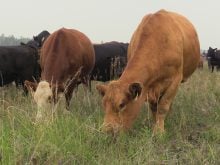Fed prices steady
Prices for fed steers and heifers held steady last week. Western Canadian fed slaughter and production volumes were both up more than seven percent compared to last year. It’s a good news story from a price perspective because producers have been able to market more fed cattle at higher prices compared to last year.
The market has rallied 27 percent from 2017 second half lows of $131 per hundredweight to the January high of $167.50. Over the past five years, the average increase from second half lows to first half highs stands at 28 percent. January highs are rare and have occurred only twice over the past 20 years.
Read Also

Message to provincial agriculture ministers: focus on international trade
International trade stakeholders said securing markets in the face of increasing protectionism should be the key priority for Canada’s agriculture ministers.
Even though the rally from low to high is in line with the five-year average, first half highs are likely not in the books yet for 2018 because fed cattle prices historically strengthen into the spring.
Given the magnitude by which the market has increased from October 2017 until now, the largest increase could be past. If this is the case, this year’s spring rally could be more moderate and less dramatic compared to 2015 and 2017.
Fed prices are expected to grind higher near term, and first-half highs in the low $170s are possible. Since the beginning of the year, cattle have been pulled ahead of schedule while cooler temperatures across the Prairies have also set cattle back.
Last week, producers indicated cattle need more days on feed before they are marketed. Light heifer trade was reported with weighted average prices fully steady with the previous week.
In its outlook, Canfax said Canadian fed cattle exports totalled 4,156 head, the fourth lowest weekly export volume over the past year, not including the week between Christmas and New Year’s. Negative processing margins will keep slaughter volumes at bay.
In the United States, major feeding states were at mostly US$128 per cwt., $2 lower than the previous week. Dressed sales in Iowa and Nebraska were steady to $2 lower. For the first six weeks of this year, steer slaughter was up one percent compared to last year and heifer slaughter was up three percent.
Cows, bulls steady
Prices for D1 and D2 cows were steady with last week’s price, at C$88.38 per cwt. on light demand. Slaughter bulls were up 18 cents to $100.07.
Western Canadian non-fed slaughter for the week ending Feb. 17 was eight percent larger than the previous week at 9,054 head. Year to date western non-fed slaughter was three percent larger at 63,058 head.
Canadian non-fed exports to the U.S. for the week ending Feb. 10 totalled 2,129 head, and year to date was 44 percent smaller at 13,134.
Ample U.S. supplies will continue to discourage non- fed exports, and local demand is lacklustre.
Feeders also stable
Alberta feeder prices stabilized and traded mostly steady last week after grinding higher during the first two weeks of February. Light calves less than 500 pounds traded mixed on tight supplies. Calves from 500-700 lb. saw continued grass interest, and prices trended fully steady to $3 higher than the previous week.
Feeders from 700-900 lb. saw prices continue generally steady while large feeders over 900 lb. saw prices ease seasonally $1-$2 lower.
Last week’s feeder index firmed modestly to $187.58. Weekly auction volumes were 34 percent larger than the previous week, totalling 32,871 head, but year to date are 22 percent smaller at 157,968 head.
Feeder exports to the U.S. for the week ending Feb. 10 rebounded to 3,051 head, and year to date were 73 percent larger, totalling 12,276 head. Feeding margins continue to deteriorate because Lethbridge barley for March delivery has climbed to around $230-$231 per tonne.
Auction volumes are expected to increase modestly from now through March. Calf prices should continue to track the historic seasonal trend, and prices should firm modestly higher. Grass interest will remain supportive, but increased feedgrain and bedding costs will limit price upside. Feeders over 700 lb. are expected to see prices ease seasonally lower through March.
U.S. cutouts rise
In U.S. beef trade, Choice and Select cutouts were both up from the previous week. Choice traded at US $218.40 compared to $209.04 the previous week. Select traded at $212.06, up from $205.14 the previous week.
Canadian cut-out values for the week ending Feb. 10 moved lower with AAA and AA down C$4.53 per cwt. and $1.23 per cwt., respectively.
This cattle market information is selected from the weekly report from Canfax, a division of the Canadian Cattlemen’s Association. More market information, analysis and statistics are available by becoming a Canfax subscriber by calling 403-275-5110 or at www.canfax.ca.














